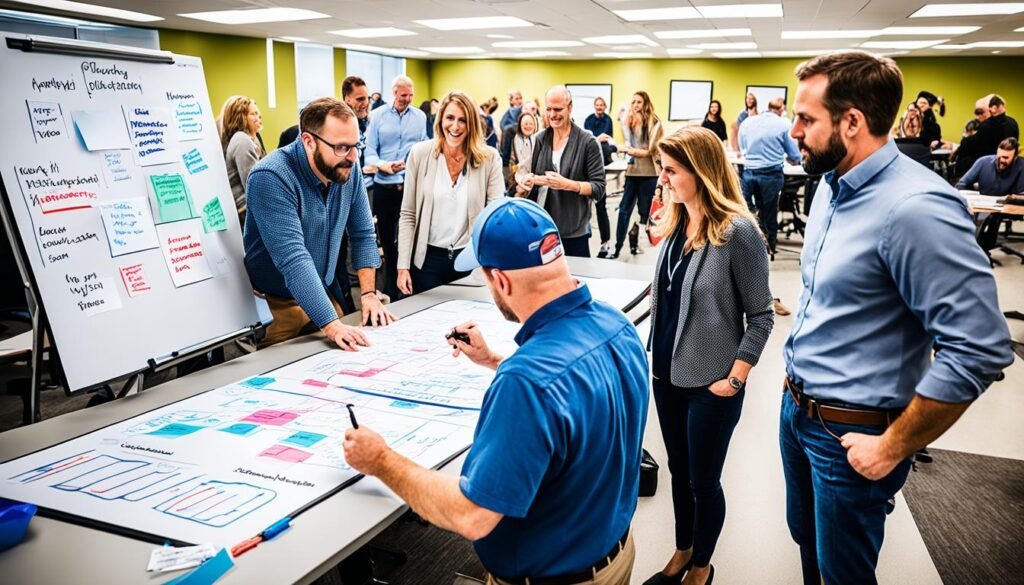Did you know 85% of employees face conflict at work? This fact shows how vital it is to know how to solve conflicts and negotiate. I’ve looked into how our minds handle disputes and what strategies work best.
In the world of conflict resolution, knowing about cognitive biases is key. These shortcuts in our thinking can mislead us, making us think we’re fair and overconfident, which can start conflicts1. By spotting these pitfalls, we can improve our negotiation and conflict solving skills.
Cognitive methods focus on thinking clearly and understanding our thought patterns. This helps us avoid acting on emotions and find better solutions. By improving these skills, we can turn conflicts at work into chances for growth and teamwork.
🎯 Ready to Transform Your Results?
Get the complete system that hundreds have used to achieve breakthrough results.
Get the Book for $7Good negotiation skills come from knowing how our minds work in conflicts. Understanding this lets us manage our and others’ reactions better. This knowledge helps us handle complex disputes smoothly and reach better outcomes for everyone1.
Key Takeaways
- Cognitive biases greatly affect conflicts
- Knowing how our minds work helps in negotiation
- Thinking clearly is key for solving disputes
- Methods for conflict resolution include negotiation and going to court
- Cognitive approaches turn conflicts into chances for growth
Understanding Cognitive Biases in Negotiation
Cognitive biases are key in shaping how we negotiate. They are mental shortcuts that can lead us away from rational thinking. This affects our ability to solve conflicts well2. As someone who negotiates, I’ve seen how these biases can turn promising talks into dead ends.
Studies show that cognitive biases often get in the way of solving conflicts. They happen because of poor communication, emotional stress, focusing too much on what we want, and feeling anxious3. This shows why it’s crucial to tackle these issues in negotiations.
- Simplifying the conflict situation
- Exaggerating the degree of opposition between parties
- Making a false dichotomy between cooperation and competition
- Favoring one’s own interests3
These biases can make us misjudge situations and lead to poor decisions. For instance, the egocentric bias makes us think we control things more than we do. The bias in judging fairness makes it hard to agree on solutions3.
The “schmooze effect” shows how important building rapport and trust is in negotiations3. This tells us to balance both the thinking and feeling parts of negotiation.
Even though cognitive biases are big in negotiations, they’re not well-studied. Most research looks at how individuals make decisions, not how groups with different interests negotiate4. This opens up chances for more research to help us understand negotiation better.
To do better in negotiations, we need training on solving conflicts. This should teach us how to avoid cognitive mistakes and biases3. By knowing and fixing these mental errors, we can lead to better and more beneficial negotiations.
The Role of System 1 and System 2 Thinking in Conflict Resolution

Understanding how our minds work is crucial in conflict resolution. Our brains use two main systems: System 1 and System 2 thinking. These systems affect how we handle and solve conflicts5.
Characteristics of System 1 Thinking
System 1 thinking is fast and automatic. It’s driven by feelings and makes up most of our thinking. In fact, 98% of our brain’s work is emotional, while only 2% is rational5.
Characteristics of System 2 Thinking
System 2 thinking is slower and more conscious. It involves logical thinking and takes more effort. This type of thinking is key for complex situations or making thoughtful decisions5.
Balancing Intuition and Logic in Negotiations
In negotiations, balancing intuition and logic is key. Managers often lean on System 1 thinking but should switch to System 2 in tough situations. This switch helps avoid biases that can block effective conflict resolution5.
| Aspect | System 1 Thinking | System 2 Thinking |
|---|---|---|
| Speed | Quick | Slow |
| Nature | Automatic | Conscious |
| Basis | Emotion-based | Logic-based |
| Effort Required | Low | High |
Recognizing cognitive biases and thinking critically can help in System 2 scenarios. This can lead to better conflict resolution and negotiation results5.
Attitudinal Blinders: How Ideology Affects Judicial Decisions
Judges often make decisions based on their political views, which can affect legal outcomes. A study looked at federal court decisions from 1933 to 1987. It found big differences based on who appointed the judges.
Judges picked by Democratic presidents usually made liberal decisions in more than half the cases. On the other hand, judges chosen by Republican presidents made liberal decisions in about a third of the cases.
This shows how personal beliefs can influence decisions, even in a system meant to be fair. Ideological influences on court decisions are clear. Supporters of a ruling often praise it, while critics criticize it6.
Scientists try to lessen these biases by focusing on evidence and testable theories. This helps us see the Court’s role in social change6. But, some people react strongly to findings that question the effects of big cases like Brown v. Board of Education.
“The law in action often diverges from the law on the books, especially when human rights and national identity are at stake.”
Courts have a big impact through their decisions. They shape behavior, market trends, and social norms6. A recent article in Perspectives on Politics, titled “Law in Action: Human Rights, Conflict Resolution and National Identity,” looks at this complex issue7.
| Appointee’s Party | Liberal Decisions (%) |
|---|---|
| Democratic | 52-53% |
| Republican | 33-36% |
It’s important to understand these biases to keep faith in our justice system. We should aim for more objective decisions in court.
Strategies for Rational Negotiation Approaches

Rational negotiation is key to success in both business and personal talks. I’ll share strategies that use System 2 thinking and smart time management to boost negotiation skills.
Making a System 2 List
Creating a System 2 list means planning carefully for big talks. It helps avoid quick decisions and focus on logical thinking. By listing key points and possible outcomes, we use our analytical mind for better negotiation strategies8.
Managing Time Pressure in Negotiations
Time management is key in talks. Rushing can lead to bad choices, while having enough time helps us think carefully. Studies show that good negotiators start with a team approach, taking time to find solutions that work for everyone8. Having enough time for talks can stop conflicts and lead to better results.
Partitioning Negotiations Across Multiple Sessions
Breaking talks into several sessions has many benefits. It gives time for thinking and rethinking, which can improve our negotiation plans. This is especially useful for complex issues or when feelings are high9.
Adopting an Outsider Lens
Seeing negotiations from outside can give us new insights. This helps us get past our own biases and be more objective. By stepping back, we can understand others better and find ways to add value9.
| Strategy | Benefit | Application |
|---|---|---|
| System 2 List | Enhances logical reasoning | Pre-negotiation planning |
| Time Management | Prevents rushed decisions | During negotiation process |
| Multiple Sessions | Allows for reflection | Complex negotiations |
| Outsider Lens | Overcomes personal biases | Throughout negotiation |
Using these rational negotiation strategies can lead to better results and stronger relationships. Remember, successful negotiations often involve finding solutions that benefit everyone and understanding the psychology behind them8.
Cognitive Conflict: Definition and Importance
Cognitive conflict happens when new information challenges what we already believe10. This mental struggle can change how groups make decisions. An American psychologist named Leon Festinger first talked about this idea10.
In everyday life, cognitive conflict can show up in many areas, like at work or when making personal choices10. People might change their views or actions to feel better10. This can help them grow and make better choices10.
Cognitive conflict affects groups too. It can make teams stronger or weaker, depending on how they handle it10. Studies show that talking openly and clearly is key to dealing with these conflicts in groups10.
Design teams that are creative often argue and compromise, while less creative teams tend to work together more11. This shows how complex the link between conflict and creativity can be.
Cognitive conflict has been a teaching tool since the 1980s, especially in science classes12.
Some experts believe cognitive conflict helps people learn and change their views. Others think it doesn’t always lead to change12. This debate shows how complex cognitive conflict is and its effects on learning and teamwork.
| Aspect | Cognitive Conflict | General Conflict |
|---|---|---|
| Focus | Discrepancies in cognitive structures | Conflicting motives and needs |
| Resolution | Changing beliefs or behaviors | Compromise or negotiation |
| Impact | Personal growth and learning | Interpersonal or social outcomes |
Knowing how to handle cognitive conflict is key for boosting innovation, improving team work, and personal growth. This is true in schools and workplaces alike.
Distinguishing Between Cognitive and Affective Conflict

In group dynamics, knowing the different types of conflict is key to managing them well. Let’s look at cognitive and affective conflict, which are two main types that affect team interactions.
Characteristics of Cognitive Conflict
Cognitive conflict is about disagreements on tasks and issues, not personal feelings. It’s about “what,” “when,” and “why” things need to be done13. Teams that work well often have these kinds of conflicts, which can make them perform better if managed right13.
Characteristics of Affective Conflict
Affective conflict is emotional and comes from personal relationships. It can make people feel more stressed and angry1314. This kind of conflict can lead to mistrust and poor communication14.
Impact on Group Dynamics
These conflicts have a big effect on how teams work together. Cognitive conflict, when handled well, can make things clearer, spark new ideas, and help focus on what’s important14. But affective conflict can make teams less united, limit good judgment, and lower performance1314.
High-achieving teams aim to keep a bit of cognitive conflict going13. To boost cognitive conflict, teams should be diverse, avoid bossy leaders, and talk about important task aspects13. But, it’s important to watch these situations closely to stop them from turning into affective conflict13.
The Benefits of Cognitive Conflict in Problem-Solving
Cognitive conflict is key in solving problems by boosting critical thinking and challenging old ideas. When people face cognitive conflict, they gain a deeper understanding of issues. This often leads to more creative solutions.
In schools, cognitive conflict is a strong tool for learning important skills. Students who go through cognitive conflict get better at reasoning and thinking deeply about their actions. This is seen a lot in fixing algebra mistakes, where using cognitive conflict helps students think better15.
Cognitive conflict also helps outside of school. At work, being flexible in thinking is a big part of it. This skill helps people deal with uncertainty and change in their jobs16. It’s very important for solving problems in today’s fast-paced work world.
| Cognitive Conflict Benefits | Impact on Problem-Solving |
|---|---|
| Enhanced Critical Thinking | Leads to more thorough analysis of problems |
| Improved Reasoning Abilities | Facilitates better decision-making processes |
| Increased Cognitive Flexibility | Enables adaptation to changing circumstances |
| Diverse Perspective Consideration | Results in more comprehensive solutions |
By using different views and trying new ways, we can make our thinking more flexible when solving problems16. This approach doesn’t just lead to better solutions. It also encourages a culture of innovation and ongoing improvement in schools and workplaces.
Conflict Resolution Techniques for Effective Negotiation

In today’s complex world, knowing how to solve conflicts is key for successful talks. These skills turn tough situations into chances for growth and working together.
Active Listening and Empathy
Active listening is a strong tool for solving conflicts. It helps us understand others’ views, find common ground, and reach agreements17. This method builds trust and focuses on the issue, not personal feelings18.
Reframing Issues and Perspectives
Reframing is vital for finding common ground. By looking for shared interests, we can make solutions that benefit everyone18. This often brings out new solutions we hadn’t thought of before.
Collaborative Problem-Solving Approaches
Working together to solve problems is crucial for resolving conflicts. It means bringing everyone involved to the table, finding solutions they all agree on, and checking how things go19. This method encourages open talk and helps mend relationships.
| Technique | Benefit |
|---|---|
| Active Listening | Builds trust and understanding |
| Reframing | Reveals new perspectives and solutions |
| Collaborative Problem-Solving | Promotes open communication and relationship rebuilding |
Using these techniques, we can turn disputes into chances for growth and understanding each other better. Remember, being patient is key. It helps us handle crises well and get good results17.
Overcoming Overconfidence Bias in Negotiations
Overconfidence bias is a big problem in negotiations. Many entrepreneurs think they’ll succeed at 70% or more, with some even feeling sure they’ll win20. This high self-confidence can lead to big mistakes in negotiations.
Knowing yourself is the first step to beating overconfidence. Things like availability bias and confirmation bias can make you overconfident21. By understanding these biases, you can stay realistic.
To fight overconfidence, prepare well. Learn about the other side and aim for solutions that benefit everyone21. It’s important to know a lot about everyone involved, especially when the stakes are high22.
Having a devil’s advocate during planning is very helpful. It makes you question your own ideas and look at different outcomes21. This method is great for fixing biases and fighting overconfidence22.
Good negotiators aren’t scared to ask for what they want. Don’t let fear stop you from negotiating well22. By being self-aware and well-prepared, you can beat overconfidence and do better in your negotiations.
The Impact of Cognitive Conflict on Learning and Development

Cognitive conflict is key to personal growth and critical thinking. It makes people question their beliefs and look at things from new angles. This helps them grow intellectually.
Personal Growth Through Cognitive Conflict
Cognitive conflict helps people grow by making them step out of their comfort zones. When they face different ideas, they must rethink their beliefs and learn more. This is vital for seeing the world in a deeper way23.
Studies show that having diverse thoughts helps groups do better. This is true in schools too, where teaching methods that challenge have been popular since the 80s23.
Enhancing Critical Thinking Skills
Cognitive conflict boosts critical thinking. It makes learners:
- Question assumptions
- Analyze different viewpoints
- Develop logical arguments
- Synthesize information from various sources
Research says cognitive conflict has four main parts: noticing something odd, being interested, feeling anxious, and changing how you think23. These parts together create a space for deep learning and personal growth.
“Conflicts have the potential for producing both highly constructive and highly destructive outcomes, depending on how they are managed.”
By welcoming cognitive conflict, we can make learning more powerful. It leads to big personal and intellectual growth. The trick is to handle these conflicts well to use their good side2423.
Implementing Cognitive Conflict Strategies in the Workplace

In today’s diverse workplaces, managing conflicts is key. The Thomas-Kilmann model shows five main ways to handle conflicts: Avoiding, Competing, Accommodating, Collaborating, and Compromising25. Each method fits different situations and goals.
Using these strategies well can make a workplace better and more productive. Diverse teams make better decisions by focusing on facts26. And teams with mixed-gender leaders often make more money26. This shows how important it is to manage conflicts well.
- Encourage open dialogue
- Train employees in conflict resolution techniques
- Set clear boundaries and expectations
- Foster a culture of respect and collaboration
Did you know 50% of HR workers spend one to five hours a week on conflict resolution26? This shows we need good strategies. By picking the right approach, organizations can make a healthier work environment. This environment values different viewpoints.
| Strategy | Description | Best Used When |
|---|---|---|
| Collaborating | Productive discussions leading to mutually beneficial solutions | Long-term relationships are important |
| Compromising | Partial satisfaction for all parties involved | Time is limited and a quick solution is needed |
| Accommodating | Prioritizing others’ needs over one’s own | Preserving harmony is more important than the issue |
Remember, using cognitive conflict strategies isn’t about avoiding disagreements. It’s about using them for innovation and growth. By doing this, organizations can create a place where diverse ideas and teamwork thrive.
Mediation Skills for Managing Cognitive Conflicts

Managing cognitive conflicts is key in many areas. As a mediator, I’ve seen how the right approach can turn tense situations into useful talks. In fact, 88% of employees think good conflict resolution skills boost productivity and happiness27.
Facilitation Techniques for Group Discussions
I make sure group discussions are safe and open. This is crucial since 76% of workers face conflicts at work27. To help, I use methods like:
- Encouraging active listening
- Promoting equal participation
- Summarizing key points
- Asking clarifying questions
Neutrality and Impartiality in Mediation
Being impartial is key to trust in mediation. I aim to stay neutral and not take sides. This way, everyone feels heard and valued, making a resolution more likely. Task conflict, when handled right, can spark creativity and better decisions28.
Using these skills, I’ve seen that 95% of professionals believe conflict resolution skills are vital for reaching goals27. This shows how important it is to develop and improve these skills in both our personal and work lives.
Nonviolent Communication in Conflict Resolution

Nonviolent communication (NVC) is a powerful way to calm down conflicts. It was created by Marshall B. Rosenberg in the 1960s. It’s all about listening with empathy and saying what you need clearly without judging29.
The NVC process to solve conflicts has five steps:
- Expressing personal needs
- Identifying others’ needs
- Verifying mutual understanding
- Providing empathy
- Proposing solutions that meet everyone’s needs30
NVC is different from traditional mediation, which looks for a middle ground. NVC aims to satisfy everyone’s needs30. It encourages honest requests, letting people say no without fear30.
Listening with empathy is key in NVC. It means understanding what people mean, even if it’s not said out loud30. By focusing on feelings, needs, and requests, NVC makes talking through conflicts easier29.
“The heart of NVC is connection – it’s about meeting human needs and fostering understanding.”
To use NVC well, don’t use language that points fingers or makes someone feel wrong. Talk about what you need instead of what you want to do30. This way, conflicts can turn into chances for growth and stronger bonds, as shown by the NVC Conflict Resolution Center.
| Traditional Mediation | Nonviolent Communication |
|---|---|
| Aims for compromise | Seeks to meet all needs fully |
| May use blame or judgment | Avoids labeling or implying wrongness |
| Focuses on strategies | Emphasizes expressing needs |
| May overlook indirect expressions | Acknowledges nonverbal cues and indirect needs |
Collaborative Approaches to Dispute Settlement
Collaborative methods are key for solving conflicts. They focus on what people really want, not just what they say they want. This leads to better and lasting solutions31. By negotiating based on interests, everyone can find a way that works for everyone.
Interest-Based Negotiation Techniques
Interest-based negotiation is a big part of solving disputes together. It makes people look past their immediate wants to see what they really need. This way, negotiators can come up with creative that everyone likes. Mediation uses these methods to help people agree32.
Building Consensus Among Conflicting Parties
Getting everyone to agree is key in solving disputes together. It means building trust, talking openly, and working together to find a solution. The RICS Conflict Avoidance Process (CAP) is a way to build consensus early and avoid long, harmful disputes32. This can save money and make solving conflicts faster, which is important for peace and development in fragile societies31.
In my experience, working together to solve disputes is the best way to manage conflicts well. Methods like interest-based negotiation and building consensus help solve problems now and build strong relationships for the future31.
FAQ
What are cognitive approaches to conflict resolution and negotiation skills?
Cognitive approaches help us understand and manage our biases in making decisions. They stress the need for rational thinking and being aware of our thought processes. This helps in solving disputes and negotiating better.
How do cognitive biases impact negotiation outcomes?
Cognitive biases, like attitudinal blinders, greatly affect how we negotiate. For example, judges’ political views can change their decisions. Democratic judges tend to make more liberal decisions than Republican ones.
What is the difference between System 1 and System 2 thinking?
System 1 thinking is quick, automatic, and intuitive. System 2 thinking is slower, more conscious, and requires effort. Relying too much on System 1 can lead to biased decisions, especially in complex situations.
How can attitudinal blinders affect judicial decision-making?
Studies show that judges’ political backgrounds greatly influence their decisions. Judges from different administrations tend to rule more liberal or conservative. This shows how biases can shape decisions, especially in political cases.
What strategies can promote rational negotiation?
To negotiate rationally, make a System 2 list of important negotiations. Manage time well by giving enough time for talks. Break negotiations into several sessions for reflection. Also, see things from an outsider’s view to get a clearer perspective.
What is cognitive conflict, and why is it important?
Cognitive conflict happens when new information challenges our old beliefs. It’s a form of discomfort that can be good or bad for groups. In diverse groups, it can lead to better understanding and creative solutions.
How does cognitive conflict differ from affective conflict?
Cognitive conflict is about disagreements on tasks and ideas, not personal traits. It encourages open talks and creative solving. Affective conflict, however, sees differences as personal attacks, hurting group relationships.
What are the benefits of cognitive conflict in problem-solving?
Cognitive conflict boosts problem-solving by promoting critical thinking and challenging old ideas. It leads to a deeper understanding of issues and can spark innovative solutions. In schools, it helps develop critical thinking and self-reflection skills.
What conflict resolution techniques are effective for negotiations?
Good conflict resolution includes listening well to understand all views, reframing issues to find common ground, and solving problems together. These methods help move past just sticking to positions and focus on what really matters and creative solutions.
How can overconfidence bias be overcome in negotiations?
Overconfidence bias often leads negotiators to set unrealistic goals. It’s important to recognize and reduce this bias for realistic goals and effective negotiation strategies.
How does cognitive conflict impact learning and development?
Cognitive conflict is key to learning and growth. It makes us question our beliefs and consider new views, promoting personal growth. In schools, it improves critical thinking, reasoning, and self-reflection.
How can cognitive conflict strategies be implemented in the workplace?
In the workplace, promote cognitive conflict by valuing diverse views and encouraging open discussions. But, manage these conflicts well to avoid productivity drops or project delays. Finding a balance between cognitive conflict and team unity is crucial for innovation and solving problems.
What mediation skills are crucial for managing cognitive conflicts?
Mediation skills are vital for handling cognitive conflicts. Good facilitation techniques ensure all views are heard. Neutrality and impartiality are key for mediators to guide parties to solutions without personal biases.
How can nonviolent communication techniques aid in conflict resolution?
Nonviolent communication focuses on sharing observations, feelings, needs, and requests without blame. This approach can calm conflicts and build understanding. Listening with empathy and clearly sharing needs are key parts of this method.
What are collaborative approaches to dispute settlement?
Collaborative approaches focus on finding what everyone needs, not just what they want. They use interest-based negotiation to find solutions that benefit all. Building trust, open communication, and a shared goal to resolve issues are essential for success.
